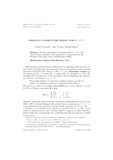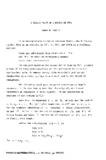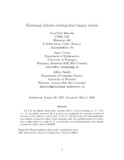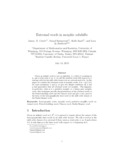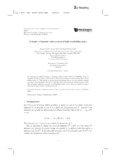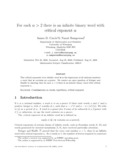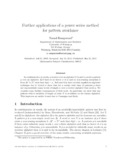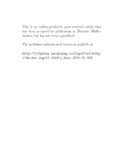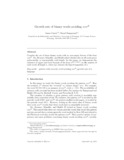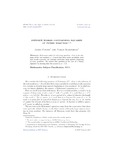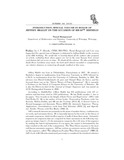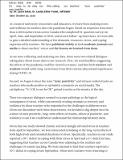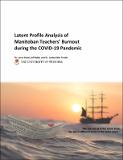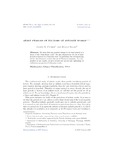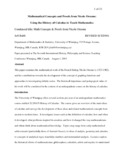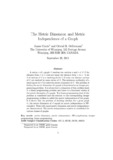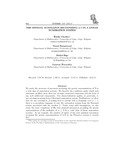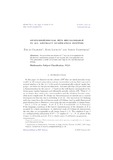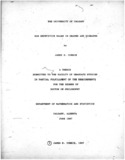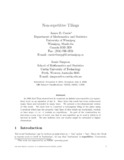Browsing Department of Mathematics and Statistics by Title
Now showing items 27-46 of 73
-
Dejean's conjecture holds for n ≥ 27
(EDP Sciences, 2009)We show that Dejean’s conjecture holds for n ≥ 27. This brings the final resolution of the conjecture by the approach of Moulin Ollagnier within range of the computationally feasible. -
A direct proof of a result of Thue
(Utilitas Mathematica, 1984) -
Extremal Infinite Overlap-Free Binary Words
(The Electronic Journal of Combinatorics, 1998-05-03)Let t be the infinite fixed point, starting with 1, of the morphism μ:0→01, 1→10. An infinite word over {0,1} is said to be overlap-free if it contains no factor of the form axaxa, where a∈{0,1} and x∈{0,1}∗. We prove that ... -
Extremal words in morphic subshifts
(Elsevier, 2014-01-22)Given an infinite word x over an alphabet A, a letter b occurring in x, and a total order \sigma on A, we call the smallest word with respect to \sigma starting with b in the shift orbit closure of x an extremal word of ... -
A family of formulas with reversal of high avoidability index
(World Scientific, 2017)We present an infinite family of formulas with reversal whose avoidability index is bounded between 4 and 5, and we show that several members of the family have avoidability index 5. This family is particularly interesting ... -
For each a > 2 there is an Infinite Binary Word with Critical Exponent a
(The Electronic Journal of Combinatorics, 2008-08-31)The critical exponent of an infinite word w is the supremum of all rational numbers α such that w contains an α-power. We resolve an open question of Krieger and Shallit by showing that for each α>2 there is an infinite ... -
Further applications of a power series method for pattern avoidance
(The Electronic Journal of Combinatorics, 2011-06-21)In combinatorics on words, a word w over an alphabet ∑ is said to avoid a pattern p over an alphabet ∆ if there is no factor x of w and no non-erasing morphism h from ∆* to ∑* such that h(p) = x. Bell and Goh have recently ... -
Generating self-complementary uniform hypergraphs
(Discrete Mathematics, 2010-02)In 2007, Szymanski and Wojda proved that for positive integers n; k with k less than n, a self-complementary k-uniform hypergraph of order n exists if and only if n/k is even. In this paper, we characterize the cycle type ... -
Growth rate of binary words avoiding xxxR
(Elsevier, 2016-01)Abstract Consider the set of those binary words with no non-empty factors of the form xxx^R. Du, Mousavi, Schaeffer, and Shallit asked whether this set of words grows polynomially or exponentially with length. In this ... -
Infinite words containing squares at every position
(EDP Sciences, 2010)Richomme asked the following question: what is the infimum of the real numbers α > 2 such that there exists an infinite word that avoids α-powers but contains arbitrarily large squares beginning at every position? We resolve ... -
It’s okay to be okay too. Why calling out teachers’ “toxic positivity” may backfire
(Canadian Education Network, 2020) -
Latent Profile Analysis of Manitoban Teachers' Burnout during the COVID-19 Pandemic
(University of Winnipeg, 2021-03) -
Least Periods of Factors of Infinite Words
(EDP Sciences, 2009)We show that any positive integer is the least period of a factor of the Thue-Morse word. We also characterize the set of least periods of factors of a Sturmian word. In particular, the corresponding set for the Fibonacci ... -
Mathematical Concepts and Proofs from Nicole Oresme: Using the History of Calculus to Teach Mathematics
(2005)This paper examines the mathematical work of the French bishop, Nicole Oresme (c. 1323–1382), and his contributions towards the development of the concept of graphing functions and approaches to investigating infinite ... -
The metric dimension and metric independence of a graph
(The Charles Babbage Research Centre, 2001)A vertex x of a graph G resolves two vertices u and v of G if the distance from x to u does not equal the distance from x to v. A set S of vertices of G is a resolving set for G if every two distinct vertices of G are ... -
The minimal automaton recognizing mN in a linear numeration system
(Integers, 2011-12-02)We study the structure of automata accepting the greedy representations of N in a wide class of numeration systems. We describe the conditions under which such automata can have more than one strongly connected component ... -
Multi-dimensional sets recognizable in all abstract numeration systems
(EDP Sciences, 2011)We prove that the subsets of Nd that are S-recognizable for all abstract numeration systems S are exactly the 1-recognizable sets. This generalizes a result of Lecomte and Rigo in the one-dimensional setting. -
Non repetitive walks in graphs and digraphs
(The University of CalgaryUniversity of Calgary, 1987-06)A word $w$ over alphabet $\Sigma$ is {\em non-repetitive} if we cannot write $w=abbc$, $a,b,c\in\Sigma^*$, $b\ne\epsilon$. That is, no subword of $w$ appears twice in a row in $w$. In 1906, Axel Thue, the Norwegian number ... -
Non-Repetitive Tilings
(The Electronic Journal of Combinatorics, 2002-07-03)In 1906 Axel Thue showed how to construct an infinite non-repetitive (or square-free) word on an alphabet of size 3. Since then this result has been rediscovered many times and extended in many ways. We present a two-dimensional ...

